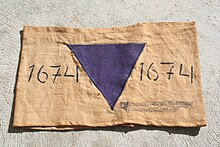The purple triangle was a concentration camp badge used by the Nazis to identify Bibelforsher (that is Bible Student movement and Jehovah's Witnesses) in Nazi Germany. The purple triangle was introduced in July 1936 with other concentration camps such as those of Dachau and Buchenwald following in 1937 and 1938.[1] In the winter of 1935–36, before the onset of the war, Jehovah’s Witnesses have been reported to make up 20–40% of the prisoners in concentration camps.[2] Although Jehovah's Witnesses made up the vast majority of those wearing the purple triangle (over 99%), a few members of other small pacifist religious groups were also included.[3][4][5]

Background
editJehovah's Witnesses came into conflict with the Nazi regime because they refused to use the Hitler salute, which conflicted with their beliefs. Because refusing to use the Hitler salute was considered a crime, they were arrested, and their children attending school were expelled, detained and separated from their families. When Germany made military enlistment mandatory, they were persecuted because they refused to bear arms. Being politically neutral, they also refused to vote in the elections.[6]
Based on the Nuremberg Laws, those who were also classified as ethnic Jews wore a badge comprising a purple triangle superimposed on a yellow triangle.
See also
editReferences
edit- ^ Eberle, A. (2005) 'Hiiftlingskategorien und Kennzeichen', in Benz and Distel, 2005a, pp. 91-109.
- ^ Johannes S. Wrobel, Jehovah's Witnesses in National Socialist Concentration Camps, 1933–45, Religion, State & Society, Vol. 34, No. 2, June 2006, pp. 89–125 ”…although overall figures remain unavoidably imprecise, the number of Jehovah’s Witnesses in the concentration camps in the winter of 1935–36 probably ranged from about 600 (20 per cent) to 1000 (40 per cent).”
- ^ Memorial and Museum AUSCHWITZ-BIRKENAU. "Categories of Prisoners - Jehovah's Witnesses". Retrieved 15 February 2019.
- ^ "Knocking | Jehovah's Witnesses | Independent Lens". PBS. Retrieved 2022-01-31.
- ^ "Holocaust Revealed". Holocaust Revealed. Archived from the original on 2012-12-03. Retrieved 2012-12-29.
- ^ King, Christine. "Leadership Lessons from History: Jehovah's Witnesses." The International Journal of Leadership in Public Services 7, no. 2 (2011): 178–185. doi:10.1108/17479881111160168.
External links
edit- Jehovah's Witnesses Stand Firm Against Nazi Assault
- US Holocaust Memorial Museum summary
- "Jehovah's Witnesses in Germany" University of Minnesota's Center for Holocaust and Genocide Studies
- "Jehovah's Witnesses in National Socialist concentration camps, 1933–45, by Johannes S. Wrobel, Religion, State and Society vol. 34, no. 2 (June 2006), 89–125
- Purple Triangles: A Story of Spiritual Resistance by Jolene Chu, originally published in Judaism Today, No. 12, Spring 1999
- "On Auschwitz" (17): prisoners with purple triangles – Jehovah’s Witnesses in Auschwitz by the official podcast of the Auschwitz Memorial, 2023
- Purple Triangle: An Untold Story of the Holocaust
- They Triumphed Over Persecution, The Watchtower March 1, 2003
- Garbe, Detlef (2008). Between Resistance and Martyrdom: Jehovah's Witnesses in the Third Reich. Washington, DC, and Madison, Wisconsin: United States Holocaust Memorial Museum in association with University of Wisconsin Press.
- Watchtower Bible and Tract Society (Distributor) (1991). Purple Triangles (VHS). United States of America: Starlock Pictures.